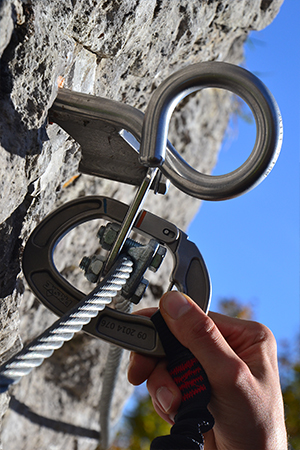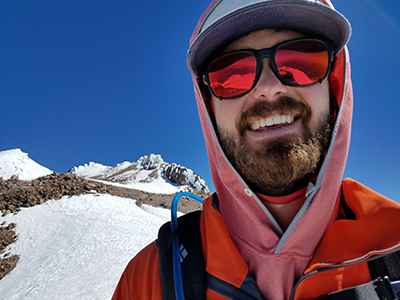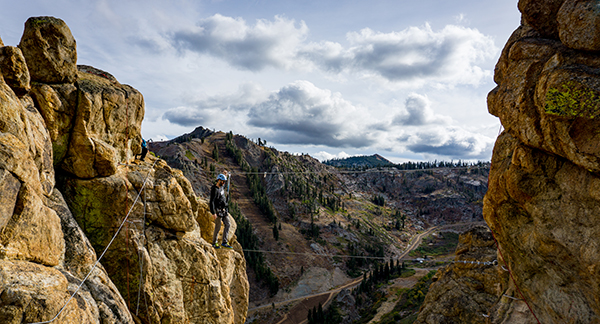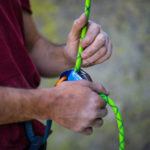How do Tahoe Via Ferrata Guides Manage Inherent Risk?


“Is this safe?”
As guides, we are often asked the question, “Is this safe?” And, if we were to give you the short answer, it would be “NOPE!” because pretty much everything fun is at least a little dangerous.
Entering into any mountainous environment involves inherent risk. Acknowledging that fact, here’s what we do at the Tahoe Via Ferrata to manage danger as effectively as possible. In the following interview with guide Will Sperry, we list out some of the hazards that you may encounter on the via ferrata and how our guide team handles them.
To start us off, Will gives us a rundown on basic mountain awareness.
“Recreating in the mountains is more dangerous than walking through the park. We are literally on the side of a cliff, enjoying the beauty of Tram Face at Squaw Valley. In the mountains we have objective (inherent) & subjective (voluntary) risk. As guides, it is our responsibility to minimize & mitigate as much subjective risk as possible. But that still leaves us with a few objective or inherent risks as we approach the Via: We could fall, a falling rock could strike us, we could get cuts from the course rock, we could get sunburned, or we could get heat related illness. These are just a few that, as guides, we are most concerned about.”

What are some of the things we do to help mitigate inherent risks associated with the mountains and the Tahoe Via?

1. We use The Continuous Lifeline Lanyard.
“On the via we use an amazing new piece of via technology invented by the team who installed the route. With the Continuous Lifeline System you only have one carabiner to manage verses two with the traditional via ferrata system. Once you are on the cable, you cannot unclip until you reach the end of the cable. Guides do cary special keys in case you need to exit the cable before the end of the line.”
2. We “move with conviction” to avoid falling.
“The via ferrata lanyard and harness keep us connected to the cliff while we are in exposed terrain. That said, a fall would not be a fun experience. Although the harness and lanyard would keep us connected to the cable, we would likely end up with scrapes & bruises. So, while the harness and lanyard are our last resort, our guides are very skilled in pacing, instructing, and demonstrating proper technique while climbing the Via. We dial back the speed and intensity so you as the climber can be fully present and focused on each move. We like to emphasize using three points of contact. For example, two hands and one foot or two feet and one hand. We can coach various techniques to stay in balance while on the Via, and if you are feeling a little shaky, our guides are happy to deploy their rope for an added level of security.”
3. We stay alert for any loose or falling rock.
“To protect ourselves from any falling rocks, we wear a helmet at all times while we are on the rock. Your guide will be able to instruct you on more nuanced ways to avoid rockfall while on route. The big thing we instruct is to be mindful of your footing, so you do not kick rocks on to climbers below you, and if you happen to release a rock by accident that you yell, “ROCK!” so people below are aware.”
4. We avoid scrapes and cuts.
“The rock on Tram Face is very coarse, think 20 grit sandpaper with little granite crystals exposed. Brushing against the rock is bound to give you a little scrape. With this is mind we encourage all our guests to use our gloves as part of your safety kit and more importantly, be mindful in your movement and do not rush. The only times I personally scrape my knees is when I am rushing. If the weather allows, long pants and long sleeve shirts help add a barrier between you and the rock.” {Check out this video on what to wear}

5. We manage our sun & heat exposure.
“There is a reason cold-blooded creatures hang out on rocks, granite is a great heat conductor and radiant surface. It can get VERY hot on Tram Face when there is no wind and direct sun. You will begin to understand why lizards like to sunbathe on the rocks.
Furthermore, we are at altitude. Between 6,200-7,200’, our bodies burn through more water than if we were at sea level. With that said, it is important to show up hydrated and fueled for your adventure, with at least 1 liter of water per person and some snacks. Bring your sunscreen and if you forget, we have some in the office for you to use. A baseball cap is great to wear under your helmet, and if you don’t feel well, speak up!”
6. We watch out for our fellow climbers
“At the end of the day we like to think of each group as a team, and similar to any good team you need too have good communication. If something doesn’t look or feel right, speak up. If your group is going too fast say “Slow Down!” As guides, we understand that when we step out of our comfort zones it becomes harder to communicate our needs. Know that your needs will be accommodated to the guides’ best ability.”
7. While you don’t need any specialized climbing skills to climb the via, there are a few important safety rules to keep in mind. The Tahoe Via has age, height, and weight limitations, plus basic physical fitness requirements.
To climb in an open-enrollment via ferrata group, climbers must be:
- – 10 years old
- – Four feet tall
- – Weigh between 88 and 260 lbs
- – Be able hike for 2-3 hours
“We have found that children under 10 tend to struggle with the spatial relation skills required to manipulate the safety equipment efficiently. Our weight minimum and maximum is a product of the manufacturer’s allowable load on our lanyards. Each lanyard is equipped with a shock absorbing device, it is basically a series of nylon webbing sewn like an accordion. The shock absorber is designed to deploy under certain loads in order to protect your body from absorbing too much force. When you are under the weight limit, the shock absorber will not deploy due to a lack of force during a fall. When you are over the weight limit the shock absorber could fail at too low of a force causing you to drop unexpectedly. However, with both under & over weight limit guests, our guides are able to use their rope to belay you through vertical sections as a back up. This option does require a private group reservation as the use of the rope significantly slows progress.”

We complete daily in-house route inspections and bi-annual external inspections.
“Every day, our guides are keenly alert for any potential hazards in the field. They have their eyes peeled for loose rock, damaged cable, trash, and any form of suspicious wear & tear. If they see a hazard, our guide team can immediately radio other guides in the field and our operations team in the office to report it. Every day, guides submit written reports to the office and have an opportunity to share any observations.
Twice a year, the route is inspected by the team who built it. These pros have built numerous via ferratas and understand the materials intimately. They complete a number of different tests including visual inspections and “pull-tests” to determine how strong the rock/hardware interface is.”
Be smart, climb on!
In conclusion, although we can’t guarantee that any activity in the mountains is “safe,” our guides are committed to mitigating risk in the field so you can have the best experience possible on the Tahoe Via Ferrata.
Climb on and make good decisions out there!
 Book a Half Day Via Adventure
Book a Half Day Via Adventure
For more information about Via Ferrata at Squaw Valley or Rock Climbing at Donner Summit, or any of our other international expeditions, check out our website. For any questions call our office at 877-873-5376 or send us an email info@alpenglowexpeditions.